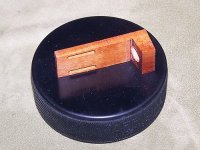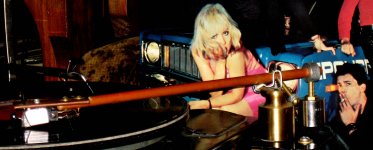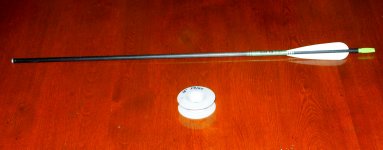All/anyone ... this may have been covered here but would take me a long time to find.
In doing prelim work on a DIY tonearm I noticed a huge calculated difference in shaft mass from 8hz to 11hz (3gms to 12gms) for the cart I plan to use (5.5 gms and compliance of 20). That is a big difference and would like to know which might be better; heavy or light if the material stays the same?
I do know there are many many variables to consider. Two important ones is that the table is fair quality (Audio Linear) and sits directly on fireplace hearth (stomp all you want on floor). Tonearm will sit on hearth also.
Thanks, Zene
In doing prelim work on a DIY tonearm I noticed a huge calculated difference in shaft mass from 8hz to 11hz (3gms to 12gms) for the cart I plan to use (5.5 gms and compliance of 20). That is a big difference and would like to know which might be better; heavy or light if the material stays the same?
I do know there are many many variables to consider. Two important ones is that the table is fair quality (Audio Linear) and sits directly on fireplace hearth (stomp all you want on floor). Tonearm will sit on hearth also.
Thanks, Zene
I realize that this is an old thread but I went by the local archery supply and asked about shafts today. The guy behind the counter showed me a dozen bins of high performance shafts. When I asked which ones were alu he said "No one uses aluminum anymore". I guess I'll have to order them online. I'd rather not have to fiddle with CF.
aluminum arrow shafts and resonant frequency calculation
All: my comp has been down for some time so I haven't been posting much.
MartinG: I use Easton aluminum shafts. Inexpensive and perfect for the application.
for resonance calculations:
M is total mass of the tonearm (effective tonearm mass, cartridge mass and mass of wiring and fasteners)
C is compliance in dynes
All: my comp has been down for some time so I haven't been posting much.
MartinG: I use Easton aluminum shafts. Inexpensive and perfect for the application.
for resonance calculations:
Rf=1000/(2*pi*sqrt(M*C))
Rf is resonant frequencyM is total mass of the tonearm (effective tonearm mass, cartridge mass and mass of wiring and fasteners)
C is compliance in dynes
What is the status of the tonearm? Anybody done?
http://www.diyaudio.com/forums/gallery/showphoto.php/photo/8253
Get ideas from "219" thread and other sites as well.
Nanook's Arm-Question re setscrew
Hi Everyone
Does anyone know what size of setscrew Nanook uses on his arm?
Hi Everyone
Does anyone know what size of setscrew Nanook uses on his arm?
Hi everyone,
Just found this thread.
Can we have a gallery of arms that have been made from arrows.
I have found an Easton hunting arrow in the loft so might as well put it to use....
a few Questions;
Effective Arm lengths ?
Female bearing ?
Type of arm cable ?
Cable exit top or bottom of arm ?
Just found this thread.
Can we have a gallery of arms that have been made from arrows.
I have found an Easton hunting arrow in the loft so might as well put it to use....
a few Questions;
Effective Arm lengths ?
Female bearing ?
Type of arm cable ?
Cable exit top or bottom of arm ?
I am sure that Nanook will jump in here with info. Lengths vary as longer arms will reduce distortion. I helped Nanook build up one of his arms one evening we used a dead simple chrome plated acorn nut for the female bearing and a ballpoint pen refill for the bearing. I have never seen an arm move freely than that one. You can go fancy but the point is dead simple will stomp on arms which retail new for thousands. Knock one together and start having some fun. You can build one of these on your kitchen table in an hour or two start to finish. Best regards Moray James.
I would agree with you. I am using an 8mm grub screw for the 'cup' and it works exceptionally well. Instead of using CF tube, I've used solid oak for the 'wand'-I hope to post some pictures soon. Instead of the ball point I'm utilising a 2mm ball bearing located on top of a 2mm bolt-simple but very effective-watch this space.......
Chris
Chris
Nanook signing in
I prefer Yamamoto style wooden headshells,🙂
Hope that helps. I could into stupid in-depth details, but these arms are very open to interpretation.
Few have made these (or have admitted to it). The "219" was inspired by the Altmann "joke" tonearm, but with better materials.Hi everyone,
Just found this thread.
Can we have a gallery of arms that have been made from arrows.
I use 300mm+ but a common construction would be modelled after the SEAC8000 tonearm: 306 mm effective length with 13mm O/H and a 293mm pivot to spindle distance. null points are: 60.6mm / 128.5mm. The O/S angle is 18°.have found an Easton hunting arrow in the loft so might as well put it to use....
a few Questions;
Arm lengths ?
a small set screw or acorn nutFemale bearing ?
silver plated 32 AWG copper, teflon dielectric, diy cartridge clipstype of arm cable ?
bottom exit.exit top or bottom of arm ?
I prefer Yamamoto style wooden headshells,🙂
Hope that helps. I could into stupid in-depth details, but these arms are very open to interpretation.
Attachments
Well then..This One works Very Well...With a Cedar Shaft, top Exit and Low CounterWeight...And, the Out-Riggers are Necessary...It will Wobble on the Vert. WithOut Them...

Attachments
Last edited:
I have a 219 waiting for me to get going and I've got a TT waiting for it. It will have to wait 'til this fall. Stew, are you coming to "The Mountain" this year?
Best Regards,
Terry
Best Regards,
Terry
Hey Stew...I have a Carbon/Graphite Shaft that I'm thinking about, and 10' of 30/44 Litz Silk Wire...But, the HeadShell has me Stumped...Unless I Carve one out of Mountain Laurel or Cherry, which will take longer than Building the whole Arm...Do You have a Better Idea?

Attachments
Last edited:
Thanks for much needed input.
The lengths etc I really had no idea it was so complicated.
Will try to work out how to upload pics
One XX75 cut in half, I intend making two Arms so sourcing different parts.
I will most likely cross brace the tubes with balsa wood & lacquer inside for extra stiffness ?
Have Litz silk copper wire.
Am thinking about twisting the 4 wires inside arm tube, & braiding from outside, (seems to me that braiding would be more supple than twisting where it matters most) with fifth wire soldered to arm tube for an earth....any comments ?
Also it occurs to me that the arm wire WILL vibrate inside the tube, If it touches the tube. So would it be prudent to loosely wrap or twist around the wire, with say some knitting wool. This would almost certainly remove any internal arm vibrations...?
re female bearing as it needs to be softer than the hardened Ball of the pen, & fixed into the arm tube. always going to be tricky whatever is used.. How about using just Hot Glue with a dimple in its centre, could be achieved by inserting quickly an Oiled/ greased knitting needle etc whilst glue is still hot....would this by now cold hot glue be much the same as Nylon/ Ptfe... any thoughts?
Wooden head shell as opposed to perhaps more solid Ali ?
Keep the ideas flowing you never know when one might work
Jay
The lengths etc I really had no idea it was so complicated.
Will try to work out how to upload pics
One XX75 cut in half, I intend making two Arms so sourcing different parts.
I will most likely cross brace the tubes with balsa wood & lacquer inside for extra stiffness ?
Have Litz silk copper wire.
Am thinking about twisting the 4 wires inside arm tube, & braiding from outside, (seems to me that braiding would be more supple than twisting where it matters most) with fifth wire soldered to arm tube for an earth....any comments ?
Also it occurs to me that the arm wire WILL vibrate inside the tube, If it touches the tube. So would it be prudent to loosely wrap or twist around the wire, with say some knitting wool. This would almost certainly remove any internal arm vibrations...?
re female bearing as it needs to be softer than the hardened Ball of the pen, & fixed into the arm tube. always going to be tricky whatever is used.. How about using just Hot Glue with a dimple in its centre, could be achieved by inserting quickly an Oiled/ greased knitting needle etc whilst glue is still hot....would this by now cold hot glue be much the same as Nylon/ Ptfe... any thoughts?
Wooden head shell as opposed to perhaps more solid Ali ?
Keep the ideas flowing you never know when one might work
Jay
Just to be very clear cos I'm only just grasping some of this.....
When you say Effective arm length does that mean from the pivot point to the approximate stylus point ?
O/H = stylus over centre of spindle: 13mm ?
Pivot to Spindle centre: 293mm
So our 12" arm is:
effectively 306mm from pivot to stylus
with stylus overhanging the spindle centre by: 13mm
& the distance of the pivot to the spindle centre is: 293mm
O/set of cartridge body relative to arm tube Is: 18deg
Sorry don't follow Null points, do I need to?
Jay
When you say Effective arm length does that mean from the pivot point to the approximate stylus point ?
O/H = stylus over centre of spindle: 13mm ?
Pivot to Spindle centre: 293mm
So our 12" arm is:
effectively 306mm from pivot to stylus
with stylus overhanging the spindle centre by: 13mm
& the distance of the pivot to the spindle centre is: 293mm
O/set of cartridge body relative to arm tube Is: 18deg
Sorry don't follow Null points, do I need to?
Jay
Jay's questions...
The lengths aren't that complicated. Now, if truth be told, I usually kinda sort of eyeball it. Because I use a base that can be re-positioned, the actual measurements are less critical than one might think.
I'll chase up or take a few pictures of what I have here currently.
Thanks for much needed input.
The lengths etc I really had no idea it was so complicated.
The lengths aren't that complicated. Now, if truth be told, I usually kinda sort of eyeball it. Because I use a base that can be re-positioned, the actual measurements are less critical than one might think.
I don't think this necessary. I have had no issues with microphonics at all, and using XX75 Easton you'll have no issues with any flex. This is not the case with thin wall carbon fibre, or super thin wall aluminium. I believe this is the reason Funk Firm uses their internal bracing. But try whatever you want to.One XX75 cut in half, I intend making two Arms so sourcing different parts.
I will most likely cross brace the tubes with balsa wood & lacquer inside for extra stiffness ?
My choice is due to what I had on hand, and it has worked well for all sorts of projects 🙂 .Litz silk copper wire.
Again, perhaps over thinking it. Just make one as quick n' dirty as possible to prove the concept to yourself. Don't spend a bunch of money sourcing high-end wire and going to lengths to mind the absolute construction of the arm. Just put it together. Of course a ground wire for the tube is necessary. Everything can be re-used if you decide the arm is worthy of serious consideration. Remember the "219" title for the arm? That's what the original cost me to make using scrounged bits. Spend as much or little as you feel suitable.Am thinking about twisting the 4 wires inside arm tube, & braiding from outside, (seems to me that braiding would be more supple than twisting where it matters most) with fifth wire soldered to arm tube for an earth....any comments ?
As no microphonics have been observed, it is not needed.it occurs to me that the arm wire WILL vibrate inside the tube, If it touches the tube. So would it be prudent to loosely wrap or twist around the wire, with say some knitting wool. This would almost certainly remove any internal arm vibrations...?
Not necessarily. If you use grade8 NPT pipe plugs or similar grade set screws for the pivot, wear will most likely not be a problem for the next century or so. The ball point will wear quicker, and they are availably so cheaply...female bearing as it needs to be softer than the hardened Ball of the pen, & fixed into the arm tube. always going to be tricky whatever is used..
I had a similar thought, and made a few arm tubes using that idea. The key is that it is best to use a metal to metal contact for wear. (in my opinion)about using just Hot Glue with a dimple in its centre, could be achieved by inserting quickly an Oiled/ greased knitting needle etc whilst glue is still hot....would this by now cold hot glue be much the same as Nylon/ Ptfe... any thoughts?
Wood is easier for most of us kitchen constructor types (without good machining capabilities) to work with rather than any metal. I also like the idea of using wood as it has some natural dampening qualities.Wooden head shell as opposed to perhaps more solid Ali ?
I'm convinced that I have hit the knee regarding the construction of these arms, and am perfectly happy with the performance in its current guise. A fair bit of thought went into the materials selection and the hardware to be used. The 219 is perfectly matched to my preferred cartridge types. [/QUOTE]the ideas flowing you never know when one might work
I'll chase up or take a few pictures of what I have here currently.
in response to sled108
You could use a piece of hardwood dowel that fits inside the shaft. Flatten one side of it, and use a piece of aluminium plate or small piece of wood. Then make yourself a Schroder style headshell as used by Schue, Clearaudio and others.
Nope. The headshell stumped me too 🙂.Hey Stew...I have a Carbon/Graphite Shaft that I'm thinking about, and 10' of 30/44 Litz Silk Wire...But, the HeadShell has me Stumped...Unless I Carve one out of Mountain Laurel or Cherry, which will take longer than Building the whole Arm...Do You have a Better Idea?
You could use a piece of hardwood dowel that fits inside the shaft. Flatten one side of it, and use a piece of aluminium plate or small piece of wood. Then make yourself a Schroder style headshell as used by Schue, Clearaudio and others.
more of Jay's questions answered...
YesWhen you say Effective arm length does that mean from the pivot point to the approximate stylus point ?
YesO/H = stylus over centre of spindle: 13mm ?
Yes, sometimes called mounting distance.Pivot to Spindle centre: 293mm
Yup.our 12" arm is:
effectively 306mm from pivot to stylus
with stylus overhanging the spindle centre by: 13mm
& the distance of the pivot to the spindle centre is: 293mm
O/set of cartridge body relative to arm tube Is: 18deg
Yes! This is what is used to align your cartridge (or more correctly the stylus tip) to the LPs being played. The specified null points are assuming you are using the SEAC8000 arm as a model to follow. I don't. I use my Oracle protractor for aligning cartridges, as I find the sound enjoyable. There are arguments for and against various alignments.don't follow Null points, do I need to?
- Status
- Not open for further replies.
- Home
- Source & Line
- Analogue Source
- my latest iteration of "Nanook's 219 tonearm"..


